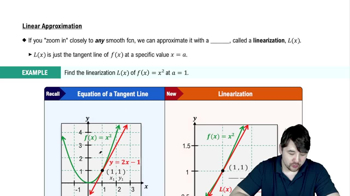Table of contents
- 0. Functions7h 52m
- Introduction to Functions16m
- Piecewise Functions10m
- Properties of Functions9m
- Common Functions1h 8m
- Transformations5m
- Combining Functions27m
- Exponent rules32m
- Exponential Functions28m
- Logarithmic Functions24m
- Properties of Logarithms34m
- Exponential & Logarithmic Equations35m
- Introduction to Trigonometric Functions38m
- Graphs of Trigonometric Functions44m
- Trigonometric Identities47m
- Inverse Trigonometric Functions48m
- 1. Limits and Continuity2h 2m
- 2. Intro to Derivatives1h 33m
- 3. Techniques of Differentiation3h 18m
- 4. Applications of Derivatives2h 38m
- 5. Graphical Applications of Derivatives6h 2m
- 6. Derivatives of Inverse, Exponential, & Logarithmic Functions2h 37m
- 7. Antiderivatives & Indefinite Integrals1h 26m
- 8. Definite Integrals4h 44m
- 9. Graphical Applications of Integrals2h 27m
- 10. Physics Applications of Integrals 2h 22m
4. Applications of Derivatives
Differentials
Problem 4.6.57`
Textbook Question
Approximating changes
Approximate the change in the volume of a right circular cylinder of fixed radius r = 20 cm when its height decreases from h = 12 to h = 11.9 cm (V(h) = πr²h).
 Verified step by step guidance
Verified step by step guidance1
Identify the formula for the volume of a right circular cylinder: \( V(h) = \pi r^2 h \), where \( r \) is the radius and \( h \) is the height.
Since the radius \( r \) is fixed at 20 cm, substitute \( r = 20 \) into the volume formula to get \( V(h) = \pi (20)^2 h = 400\pi h \).
To approximate the change in volume as the height changes from 12 cm to 11.9 cm, use the concept of differentials. The differential \( dV \) is given by \( dV = \frac{dV}{dh} \cdot dh \).
Calculate the derivative \( \frac{dV}{dh} \) of the volume function with respect to \( h \). Since \( V(h) = 400\pi h \), the derivative is \( \frac{dV}{dh} = 400\pi \).
Substitute \( dh = 11.9 - 12 = -0.1 \) cm into the differential formula \( dV = 400\pi \cdot (-0.1) \) to find the approximate change in volume.
 Verified video answer for a similar problem:
Verified video answer for a similar problem:This video solution was recommended by our tutors as helpful for the problem above
Video duration:
3mPlay a video:
Was this helpful?
Key Concepts
Here are the essential concepts you must grasp in order to answer the question correctly.
Differential Calculus
Differential calculus focuses on the concept of the derivative, which measures how a function changes as its input changes. In this context, it helps us understand how small changes in the height of the cylinder affect its volume. The derivative of the volume function with respect to height will provide the rate of change of volume as height varies.
Recommended video:

Fundamental Theorem of Calculus Part 1
Volume of a Cylinder
The volume of a right circular cylinder is given by the formula V(h) = πr²h, where r is the radius and h is the height. This formula is essential for calculating the volume based on the height and radius. In this problem, we are specifically interested in how the volume changes when the height decreases slightly.
Recommended video:

Example 5: Packaging Design
Linear Approximation
Linear approximation is a method used to estimate the value of a function near a given point using the tangent line at that point. By applying this concept, we can approximate the change in volume when the height of the cylinder changes from 12 cm to 11.9 cm. This involves using the derivative to find the slope of the tangent line at the height of 12 cm.
Recommended video:

Linearization


